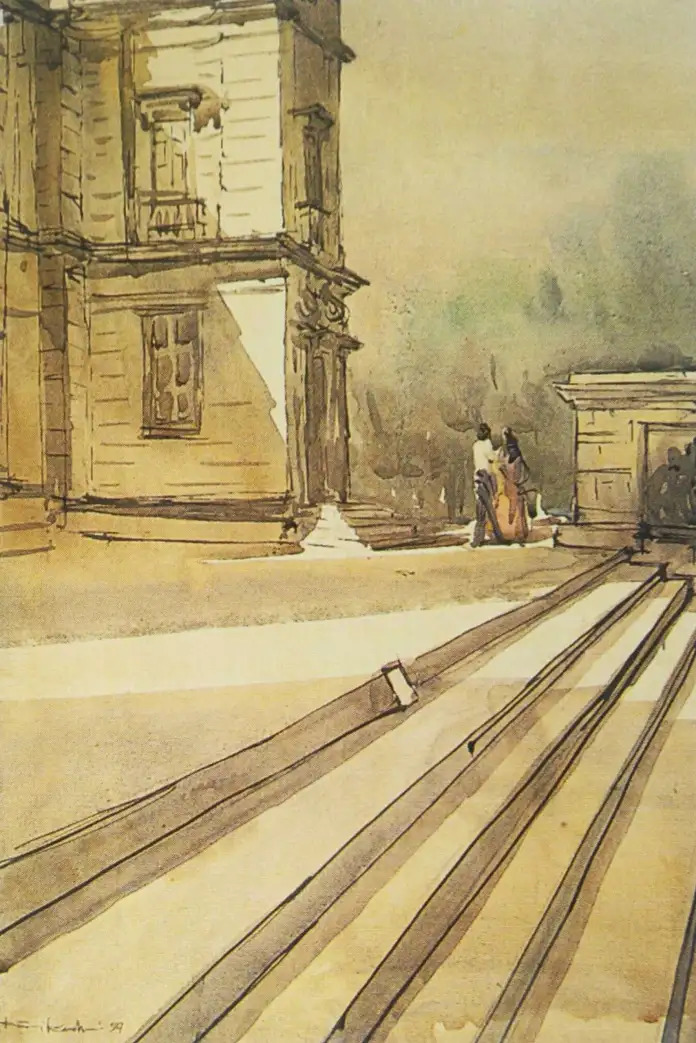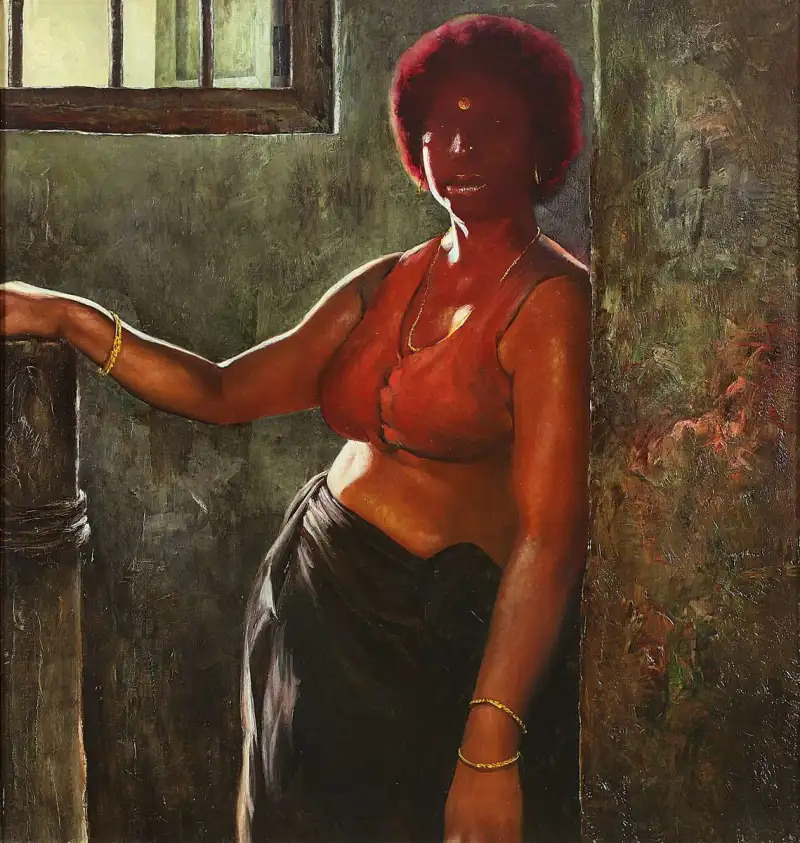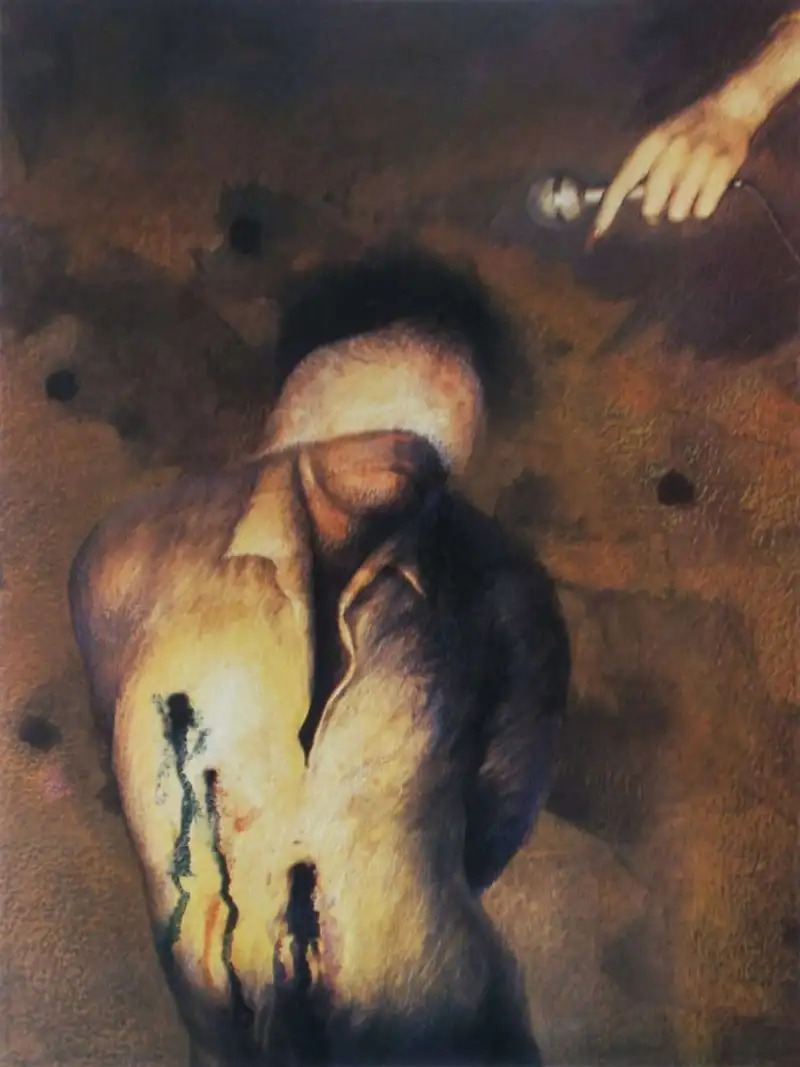The unsettling art of Bikash Bhattacharjee
Editor’s note: This deep-dive into the art of surrealist painter Bikash Bhattacharjee was first published on The Heritage Lab—a wonderful resource of stories on cultural heritage, art, museums and lots more. You can find other wonderful essays on art and culture over at their website.
About the lead image: This oil painting by Bikash Bhattacharjee is titled ‘Stiff Necked Hero’ from 1982.
At first glance, Bikash Bhattacharjee’s paintings appear to be haunting images right out of a horror movie or a bad dream. However, when you study it a little longer, a deeper and profound meaning reveals itself. We try to understand some of these underlying facets by looking at the five major themes from the groundbreaking artworks that the artist created during his lifetime.
Bikash, born in 1940 in Kolkata, lost his father when he was just six years old. He then came to live with his widowed mother in his maternal uncle’s house. Inclined towards art from a young age, he studied painting at the Indian College of Arts and Draughtsmanship. In his student days, Bikash spared no effort to train under his teachers at the college and train himself at home working more than twelve hours a day on an average.
In this day and age of social media, we are easily attracted by popular trends. The world of art is no different. In the post-independence era, when realism in art was seen as a retrograde trend, Bikash Bhattacharjee (1940-2006) embraced it and defied the norms.
The life experiences of Bikash moulded him as a painter. His intellectual and aesthetic choices began to shape the cultural and social milieu of the time. He had immense faith in his values and idealism. They provided him with the tools and standards to check, interpret and evaluate the events that happened around him. This informed the subjects of his paintings and what he portrayed, as opposed to how he portrayed it.
 The city of Calcutta (Kolkata) served as a life-long inspiration for Bikash Bhattacharjee
The city of Calcutta (Kolkata) served as a life-long inspiration for Bikash Bhattacharjee
The art of Bikash was mainly based in the city of Kolkata, where he spent his entire life. The post-independence phase saw the decline of the affluent families, who left behind their stately mansions that stood in despair. Most of the rich were reduced to middle-class who populated the narrow by-lanes and were forced to live under the same roof. For most of his free time in his teenage years, Bikash was a loner roaming around in neighbourhoods like Shobhabazar Thakur Dalan, Bagbazar, Kamartuli, Jorasanko, Chitpore etc exploring the sights and scenes of life on the streets and narrow by-lanes of North Kolkata.
 Based on his visits, Bikash created numerous studies of the city in the 1950s. His cityscapes captured the mundane life on the crowded streets, by-lanes, slums as well as views from building rooftops. These images appeared as prominent motifs in his later works. He also captured the grandeur of Victoria Memorial and the dilapidated state of Senate Hall in Calcutta University from a unique perspective. Many of the men and women who later acquired quasi-immortal life in his canvases were also imaginary renderings of characters that Bikash encountered in the neighbourhood.
Based on his visits, Bikash created numerous studies of the city in the 1950s. His cityscapes captured the mundane life on the crowded streets, by-lanes, slums as well as views from building rooftops. These images appeared as prominent motifs in his later works. He also captured the grandeur of Victoria Memorial and the dilapidated state of Senate Hall in Calcutta University from a unique perspective. Many of the men and women who later acquired quasi-immortal life in his canvases were also imaginary renderings of characters that Bikash encountered in the neighbourhood.

People in portraits by Bikash Bhattacharjee
From the 1960s onwards, the human figure appears as the central motif in the works of Bikash with near photographic realism. He considered American realist Andrew Wyeth, Francis Bacon, John Sargent, Salvador Dali and René Magritte as major influences in his art. He also admired Indian artists like Chittaprosad, Somnath Hore and Zainul Abedin who produced a body of drawings and prints, affected by the situation of the common people around them (famines, political unrest, peasant revolutions).

This was the time when twists or distortions appeared in Bikash’s paintings. His imagery is marked by what critics prefer to call a “surrealist twist”. In portraying the characters, Bikash would play with human anatomy, fuse youth with old age, generate confusion about gender and give animal morphology a human form. In nearly all of them Bikash employed a rhetorical language with a focus on allegory, metaphor and symbolism. The imagery was closely informed by the social environment and the dark corners of human subjectivity.

The Doll series: Emotional response to a violent Calcutta
Bikash chanced upon the idea of this series in the beginning of 1970s when a small girl wanted him to repair a discoloured celluloid baby doll and give it a coat of paint. It was a time when Kolkata was undergoing immense political violence (Naxal movement). Bikash witnessed some of the most gruesome killings in those clashes. One night when Bikash was returning from his downtown studio with the doll in hand, walking along the empty violence streets to his North Kolkata home, he had an epiphanic experience of trauma haunting the city and their impact upon man in his social context.
 On the following day, he conceived the Doll series. He thought of placing a baby doll, instead of a human figure, as the central motif of the desolate city-scape soaked with the terror of political violence. He located the doll in a setting where it would look abnormal. He provided the doll with vivid gestures of a living human and placed it in the focus of his canvas. As a result, every such frame provided an uncanny sensation to the viewer. The lifeless doll is juxtaposed with the human-like feelings of innocence, terror, helplessness and violence.
On the following day, he conceived the Doll series. He thought of placing a baby doll, instead of a human figure, as the central motif of the desolate city-scape soaked with the terror of political violence. He located the doll in a setting where it would look abnormal. He provided the doll with vivid gestures of a living human and placed it in the focus of his canvas. As a result, every such frame provided an uncanny sensation to the viewer. The lifeless doll is juxtaposed with the human-like feelings of innocence, terror, helplessness and violence.
Women in Bikash Bhattacharjee’s works
Woman is the recurrent central motif in nearly eighty percent of Bikash’s works. The women he painted came from different social strata and the red-light areas but mostly belonged to the middle class. The women were either impoverished and bound by the traditional society of old Kolkata or liberated from the shackles of those traditions. However, there is no one pattern to the women in Bikash’s paintings, except his empathic and insightful probe deep into their sufferings of repression.
 Bikash gave the best expression to his appreciation of women in a large body of nearly life-size paintings, titled Durga, a series he created during 1988-90. “Life without the appreciation of women would have been unthinkable for me,” Bikash had once said to explain his lifelong obsession with women. He always admired women’s immense and unique power to cope with all the constraints of traditional society and yet remain lively, loving, graceful and decent as she is expected to do, by the same society. This appreciation of women's traditional virtues is well depicted in his paintings.
Bikash gave the best expression to his appreciation of women in a large body of nearly life-size paintings, titled Durga, a series he created during 1988-90. “Life without the appreciation of women would have been unthinkable for me,” Bikash had once said to explain his lifelong obsession with women. He always admired women’s immense and unique power to cope with all the constraints of traditional society and yet remain lively, loving, graceful and decent as she is expected to do, by the same society. This appreciation of women's traditional virtues is well depicted in his paintings.

Social realism at the core of Bikash Bhattacharjee’s art
As we’ve already seen, Bikash’s portrait-based images focused on individuals he came across in his daily encounter with people around him. In each of them, he spotted the facets of the current state of social reality. His works in the 80s are satirical and critical takes on how Kolkata coped with the crisis in the basic amenities of life – whether a flooded street, scarcity of cooking gas or of drinking water.
 The gruelling impact of events like the famine of 1943 to the Partition of 1947 were quite prominent in Kolkata. Bikash saw the rapid decline of values in the social, political and even in personal life since independence. The gaps were widening between what was promised, aspired to become and the facts of reality. The brutalities of the ongoing Vietnam War that made the headlines of newspapers almost daily during the late ’60s, the Bangladesh War of 1971, the backlash of political violence on the streets of Kolkata, nationwide emergency in 1975-77 were some events that had a profound impact on him.
The gruelling impact of events like the famine of 1943 to the Partition of 1947 were quite prominent in Kolkata. Bikash saw the rapid decline of values in the social, political and even in personal life since independence. The gaps were widening between what was promised, aspired to become and the facts of reality. The brutalities of the ongoing Vietnam War that made the headlines of newspapers almost daily during the late ’60s, the Bangladesh War of 1971, the backlash of political violence on the streets of Kolkata, nationwide emergency in 1975-77 were some events that had a profound impact on him.
 Bikash had painted a wide range of subjects all drawn from his direct personal perception of contemporary life, often with an ironic critique on the social realities of his time. In the process, he remained, in his words, “true to the events”. Probably that is the reason why his paintings continue to be relevant even today. The overall identity of his paintings can be described in three key words — conservative, traditional and realist. This defined his outlook in life and art:
Bikash had painted a wide range of subjects all drawn from his direct personal perception of contemporary life, often with an ironic critique on the social realities of his time. In the process, he remained, in his words, “true to the events”. Probably that is the reason why his paintings continue to be relevant even today. The overall identity of his paintings can be described in three key words — conservative, traditional and realist. This defined his outlook in life and art:
I don’t possess any dreamlands. This is my nature throughout my life — I am very close to the event.




 souk picks
souk picks